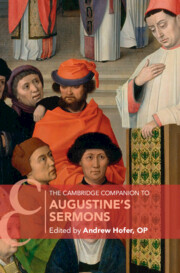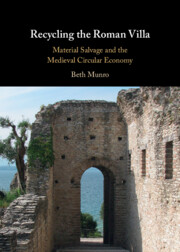Refine search
Actions for selected content:
146 results
5 - Instrumental Agency and Ecclesiastical Unity
-
- Book:
- God, Slavery, and Early Christianity
- Published online:
- 19 September 2025
- Print publication:
- 09 October 2025, pp 200-256
-
- Chapter
- Export citation
Conclusion
-
- Book:
- God, Slavery, and Early Christianity
- Published online:
- 19 September 2025
- Print publication:
- 09 October 2025, pp 257-270
-
- Chapter
- Export citation

The Cambridge Companion to Christian Liturgy
-
- Published online:
- 19 September 2025
- Print publication:
- 09 October 2025
7 - Theological Benefits of the Instrumental Doctrine
- from Part III - Theological Implications
-
- Book:
- The Humanity of Christ as Instrument of Salvation
- Published online:
- 21 August 2025
- Print publication:
- 04 September 2025, pp 201-225
-
- Chapter
- Export citation
Introduction
-
- Book:
- The Humanity of Christ as Instrument of Salvation
- Published online:
- 21 August 2025
- Print publication:
- 04 September 2025, pp 1-12
-
- Chapter
- Export citation
Introduction
-
-
- Book:
- The Cambridge Companion to Christian Heresy
- Published online:
- 17 July 2025
- Print publication:
- 31 July 2025, pp 1-14
-
- Chapter
- Export citation
Credo ut Intelligam: Anselm on Believing in the Church
-
- Journal:
- New Blackfriars ,
- Published online by Cambridge University Press:
- 28 July 2025, pp. 1-11
-
- Article
- Export citation
11 - Preaching on the Totus Christus
- from Part III - Augustine’s Preaching Themes
-
-
- Book:
- The Cambridge Companion to Augustine's Sermons
- Published online:
- 26 May 2025
- Print publication:
- 12 June 2025, pp 209-225
-
- Chapter
- Export citation
4 - Sermons on the Old Testament
- from Part II - Augustine’s Sermons on the Scriptures and Liturgical Feasts
-
-
- Book:
- The Cambridge Companion to Augustine's Sermons
- Published online:
- 26 May 2025
- Print publication:
- 12 June 2025, pp 81-97
-
- Chapter
- Export citation
1 - Augustine as Preacher and His Brethren in the Church
- from Part I - Augustine’s Pastoral Task of Preaching Sermons
-
-
- Book:
- The Cambridge Companion to Augustine's Sermons
- Published online:
- 26 May 2025
- Print publication:
- 12 June 2025, pp 25-43
-
- Chapter
- Export citation
17 - Cyprian of Carthage, On the Oneness of the Catholic Church (Second Edition)
- from Part III - Imagining the Community
-
-
- Book:
- The Cambridge Edition of Early Christian Writings
- Published online:
- 19 May 2025
- Print publication:
- 12 June 2025, pp 322-342
-
- Chapter
- Export citation

The Cambridge Companion to Augustine's Sermons
-
- Published online:
- 26 May 2025
- Print publication:
- 12 June 2025
9 - God’s Unfolding Purpose
- from Part III - Reconfiguring the Story
-
- Book:
- Constructing an Incarnational Theology
- Published online:
- 09 January 2025
- Print publication:
- 23 January 2025, pp 216-243
-
- Chapter
- Export citation
2 - The Scriptural Story
- from Part I - The Story of God
-
- Book:
- Constructing an Incarnational Theology
- Published online:
- 09 January 2025
- Print publication:
- 23 January 2025, pp 24-58
-
- Chapter
- Export citation
Strengthening Religious Ties: The Neo-Protestant Church and the Integration of Romanian Migrants in the United States
-
- Journal:
- Nationalities Papers / Volume 53 / Issue 5 / September 2025
- Published online by Cambridge University Press:
- 20 January 2025, pp. 1136-1149
-
- Article
-
- You have access
- Open access
- HTML
- Export citation
An Anglican nouvelle théologie: Eric Mascall on Christ and the Church
-
- Journal:
- Journal of Anglican Studies / Volume 22 / Issue 2 / November 2024
- Published online by Cambridge University Press:
- 13 January 2025, pp. 484-498
-
- Article
- Export citation
Answering Liberal Protestantism: Eric Mascall and Karl Barth
-
- Journal:
- Journal of Anglican Studies / Volume 22 / Issue 2 / November 2024
- Published online by Cambridge University Press:
- 13 January 2025, pp. 499-511
-
- Article
- Export citation
14 - The Body of Jesus in His People
- from Part III - Ethics, Theology, and Critical Scholarship
-
-
- Book:
- The New Cambridge Companion to Jesus
- Published online:
- 15 November 2024
- Print publication:
- 05 December 2024, pp 232-249
-
- Chapter
- Export citation

Recycling the Roman Villa
- Material Salvage and the Medieval Circular Economy
-
- Published online:
- 08 November 2024
- Print publication:
- 31 October 2024
